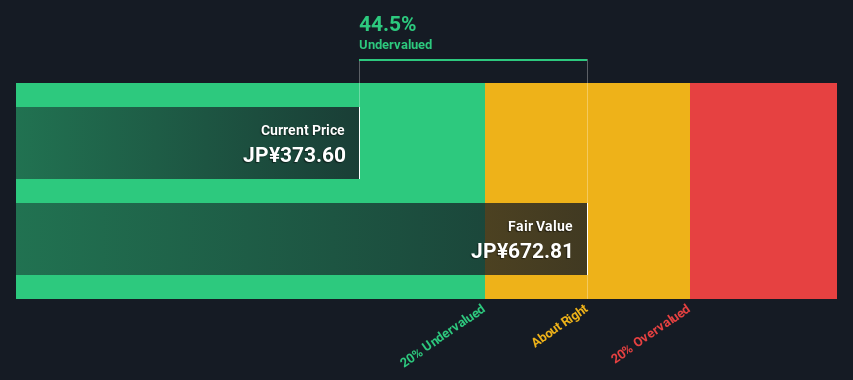Are Investors Undervaluing Sumitomo Chemical Company, Limited (TSE:4005) By 44%?

Key Insights
- Sumitomo Chemical Company's estimated fair value is JP¥673 based on 2 Stage Free Cash Flow to Equity
- Current share price of JP¥374 suggests Sumitomo Chemical Company is potentially 44% undervalued
- The JP¥453 analyst price target for 4005 is 33% less than our estimate of fair value
Does the November share price for Sumitomo Chemical Company, Limited (TSE:4005) reflect what it's really worth? Today, we will estimate the stock's intrinsic value by projecting its future cash flows and then discounting them to today's value. This will be done using the Discounted Cash Flow (DCF) model. Models like these may appear beyond the comprehension of a lay person, but they're fairly easy to follow.
Companies can be valued in a lot of ways, so we would point out that a DCF is not perfect for every situation. Anyone interested in learning a bit more about intrinsic value should have a read of the Simply Wall St analysis model.
View our latest analysis for Sumitomo Chemical Company
What's The Estimated Valuation?
We are going to use a two-stage DCF model, which, as the name states, takes into account two stages of growth. The first stage is generally a higher growth period which levels off heading towards the terminal value, captured in the second 'steady growth' period. In the first stage we need to estimate the cash flows to the business over the next ten years. Where possible we use analyst estimates, but when these aren't available we extrapolate the previous free cash flow (FCF) from the last estimate or reported value. We assume companies with shrinking free cash flow will slow their rate of shrinkage, and that companies with growing free cash flow will see their growth rate slow, over this period. We do this to reflect that growth tends to slow more in the early years than it does in later years.
Generally we assume that a dollar today is more valuable than a dollar in the future, and so the sum of these future cash flows is then discounted to today's value:
10-year free cash flow (FCF) forecast
| 2025 | 2026 | 2027 | 2028 | 2029 | 2030 | 2031 | 2032 | 2033 | 2034 | |
| Levered FCF (¥, Millions) | JP¥310.0b | JP¥68.5b | JP¥69.1b | JP¥74.0b | JP¥85.6b | JP¥90.2b | JP¥93.6b | JP¥96.2b | JP¥98.2b | JP¥99.7b |
| Growth Rate Estimate Source | Analyst x1 | Analyst x4 | Analyst x4 | Analyst x2 | Analyst x2 | Est @ 5.38% | Est @ 3.86% | Est @ 2.79% | Est @ 2.05% | Est @ 1.53% |
| Present Value (¥, Millions) Discounted @ 10% | JP¥281.4k | JP¥56.5k | JP¥51.7k | JP¥50.3k | JP¥52.8k | JP¥50.5k | JP¥47.6k | JP¥44.4k | JP¥41.2k | JP¥37.9k |
("Est" = FCF growth rate estimated by Simply Wall St)
Present Value of 10-year Cash Flow (PVCF) = JP¥714b
After calculating the present value of future cash flows in the initial 10-year period, we need to calculate the Terminal Value, which accounts for all future cash flows beyond the first stage. The Gordon Growth formula is used to calculate Terminal Value at a future annual growth rate equal to the 5-year average of the 10-year government bond yield of 0.3%. We discount the terminal cash flows to today's value at a cost of equity of 10%.
Terminal Value (TV)= FCF2034 × (1 + g) ÷ (r – g) = JP¥100b× (1 + 0.3%) ÷ (10%– 0.3%) = JP¥1.0t
Present Value of Terminal Value (PVTV)= TV / (1 + r)10= JP¥1.0t÷ ( 1 + 10%)10= JP¥387b
The total value is the sum of cash flows for the next ten years plus the discounted terminal value, which results in the Total Equity Value, which in this case is JP¥1.1t. The last step is to then divide the equity value by the number of shares outstanding. Compared to the current share price of JP¥374, the company appears quite undervalued at a 44% discount to where the stock price trades currently. The assumptions in any calculation have a big impact on the valuation, so it is better to view this as a rough estimate, not precise down to the last cent.

The Assumptions
The calculation above is very dependent on two assumptions. The first is the discount rate and the other is the cash flows. You don't have to agree with these inputs, I recommend redoing the calculations yourself and playing with them. The DCF also does not consider the possible cyclicality of an industry, or a company's future capital requirements, so it does not give a full picture of a company's potential performance. Given that we are looking at Sumitomo Chemical Company as potential shareholders, the cost of equity is used as the discount rate, rather than the cost of capital (or weighted average cost of capital, WACC) which accounts for debt. In this calculation we've used 10%, which is based on a levered beta of 1.975. Beta is a measure of a stock's volatility, compared to the market as a whole. We get our beta from the industry average beta of globally comparable companies, with an imposed limit between 0.8 and 2.0, which is a reasonable range for a stable business.
SWOT Analysis for Sumitomo Chemical Company
- No major strengths identified for 4005.
- Dividend is low compared to the top 25% of dividend payers in the Chemicals market.
- Expected to breakeven next year.
- Has sufficient cash runway for more than 3 years based on current free cash flows.
- Good value based on P/S ratio and estimated fair value.
- Debt is not well covered by operating cash flow.
- Paying a dividend but company is unprofitable.
Looking Ahead:
Whilst important, the DCF calculation ideally won't be the sole piece of analysis you scrutinize for a company. It's not possible to obtain a foolproof valuation with a DCF model. Rather it should be seen as a guide to "what assumptions need to be true for this stock to be under/overvalued?" If a company grows at a different rate, or if its cost of equity or risk free rate changes sharply, the output can look very different. Why is the intrinsic value higher than the current share price? For Sumitomo Chemical Company, there are three essential items you should look at:
- Risks: For instance, we've identified 2 warning signs for Sumitomo Chemical Company that you should be aware of.
- Future Earnings: How does 4005's growth rate compare to its peers and the wider market? Dig deeper into the analyst consensus number for the upcoming years by interacting with our free analyst growth expectation chart.
- Other High Quality Alternatives: Do you like a good all-rounder? Explore our interactive list of high quality stocks to get an idea of what else is out there you may be missing!
PS. Simply Wall St updates its DCF calculation for every Japanese stock every day, so if you want to find the intrinsic value of any other stock just search here.
New: Manage All Your Stock Portfolios in One Place
We've created the ultimate portfolio companion for stock investors, and it's free.
• Connect an unlimited number of Portfolios and see your total in one currency
• Be alerted to new Warning Signs or Risks via email or mobile
• Track the Fair Value of your stocks
Have feedback on this article? Concerned about the content? Get in touch with us directly. Alternatively, email editorial-team (at) simplywallst.com.
This article by Simply Wall St is general in nature. We provide commentary based on historical data and analyst forecasts only using an unbiased methodology and our articles are not intended to be financial advice. It does not constitute a recommendation to buy or sell any stock, and does not take account of your objectives, or your financial situation. We aim to bring you long-term focused analysis driven by fundamental data. Note that our analysis may not factor in the latest price-sensitive company announcements or qualitative material. Simply Wall St has no position in any stocks mentioned.
About TSE:4005
Sumitomo Chemical Company
Engages in Chemicals & Plastics, energy and functional materials, IT-related chemicals, health and crop sciences, pharmaceuticals, and other businesses worldwide.
Undervalued with moderate growth potential.
Similar Companies
Market Insights
Community Narratives




